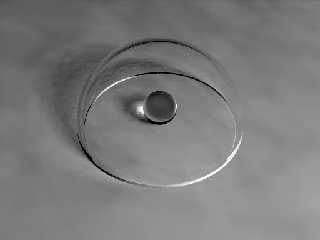|
 |
Following all this radiosity talk, I have made a minor discovery. I think
Alain hinted that this was possible in a radiosity-related post last month,
so it's probably not totally new, but it seems that when using radiosity
lighting with transparency you get caustics naturally without any need for
photon-mapping!
Did anyone else know this?
#include "colors.inc"
global_settings {
assumed_gamma 1
max_trace_level 10
radiosity {
pretrace_start 0.08
pretrace_end 0.01
count 750
nearest_count 2
error_bound 0.1
recursion_limit 12
low_error_factor 0.5
gray_threshold 0
minimum_reuse 0.0001
brightness 1
adc_bailout 0.01/2 } }
camera {
location <0, 5, -5>
angle 45
look_at <0, 0, 0> }
sphere { <10, 10, -10>, 3 pigment { color rgb 18 } finish { ambient 1 } }
difference {
sphere { <0, 0, 0>, 1.5 }
sphere { <0, 0, 0>, 1.4 }
pigment { color Clear }
finish { ambient 0 }
interior { ior 1.5 } }
sphere {
<0, 0.3, 0>, 0.3
pigment { color Clear }
finish { ambient 0 }
interior { ior 1.5 } }
plane {
<0, 1, 0>, 0
pigment { color White }
finish { ambient 0 } }
Good, eh?
Post a reply to this message
Attachments:
Download 'radtest.jpg' (47 KB)
Preview of image 'radtest.jpg'

|
 |




![]()